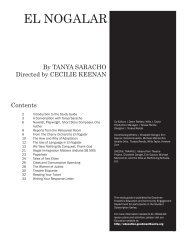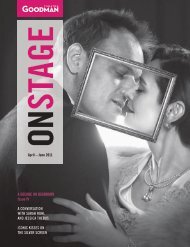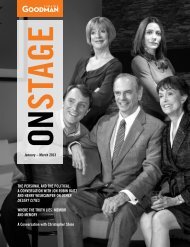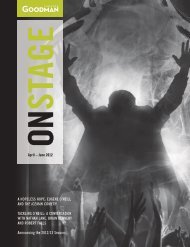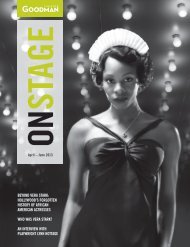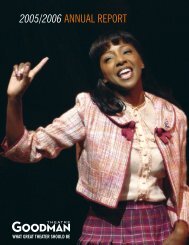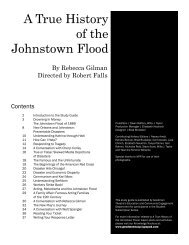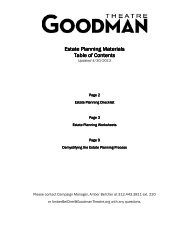Magnolia, atlanta and dr. Martin luther king jr. a ... - Goodman Theatre
Magnolia, atlanta and dr. Martin luther king jr. a ... - Goodman Theatre
Magnolia, atlanta and dr. Martin luther king jr. a ... - Goodman Theatre
Create successful ePaper yourself
Turn your PDF publications into a flip-book with our unique Google optimized e-Paper software.
OPPOSITE: Photo of Dr. <strong>Martin</strong> Luther King Jr. in the<br />
Vine City neighborhood in Atlanta, Georgia, while residents<br />
protested their living conditions. Courtesy of the<br />
Atlanta History Center, Bill Wilson Collection. RIGHT:<br />
Photo of Ebenezer Baptist Church in Atlanta, Georgia,<br />
courtesy of photographer Stu Jenks. Photo of Peachtree<br />
Street <strong>and</strong> Auburn Avenue courtesy of Geographic<br />
Places, Lane Brothers Photographers Collection <strong>and</strong><br />
Tracy O’Neill Collection, Special Collections Department,<br />
Georgia State University Library.<br />
Set in Atlanta, Georgia, in early 1963,<br />
<strong>Magnolia</strong> captures a place <strong>and</strong> time when<br />
all assumptions were being reexamined<br />
<strong>and</strong> the earth was shifting under people’s<br />
feet. The impetus for the play came from<br />
playwright Regina Taylor’s desire to honor<br />
the legacy of Dr. <strong>Martin</strong> Luther King Jr.<br />
She began her journey by studying the<br />
people <strong>and</strong> history of King’s birthplace.<br />
Born on January 15, 1929, King was the<br />
eldest son of Alberta King (née Williams)<br />
<strong>and</strong> the Reverend Mike King, who later<br />
changed both his <strong>and</strong> his son’s name to<br />
<strong>Martin</strong> Luther in honor of the 16th century<br />
theologian. King’s maternal gr<strong>and</strong>father,<br />
A.D. Williams, was a former slave<br />
preacher who had worked his way up in<br />
Atlanta’s black community to become the<br />
preacher at Ebenezer Baptist Church. It<br />
was this pulpit that King’s father would<br />
assume in due time.<br />
The Atlanta of King’s childhood suffered<br />
from the same racist acrimony <strong>and</strong> violence<br />
as the rest of the South, but what<br />
set the city apart from its region was<br />
its thriving black community. Auburn<br />
Avenue, the street where King grew up<br />
<strong>and</strong> Ebenezer Baptist Church stood, was<br />
a lively strip of restaurants, offices, small<br />
businesses <strong>and</strong> nightspots that came to<br />
be known as Sweet Auburn.<br />
In his historical narrative Where<br />
Peachtree Meets Sweet Auburn journalist<br />
Gary M. Pomerantz charts the parallel<br />
histories of two Atlantas—one black <strong>and</strong><br />
centered around Sweet Auburn, the other<br />
white, wealthy <strong>and</strong> centered around<br />
Peachtree Street. In a telling episode,<br />
Pomerantz describes a <strong>dr</strong>ive he took with<br />
Maynard Jackson—the former mayor of<br />
Atlanta <strong>and</strong> the first black mayor of a<br />
<strong>Magnolia</strong> Synopsis<br />
Atlanta, 1963. Even as <strong>Martin</strong> Luther King Jr. inspires Atlanta’s black citizens to fight<br />
passionately for their civil rights, the new mayor erects “Peyton Wall” to restrict where<br />
they can live. Amid these churning social currents, the <strong>Magnolia</strong> Estate faces foreclosure,<br />
pitting the sensual, free-spirited heiress Lily Forrest against Thomas, a strong-willed businessman<br />
who lays claim to the estate where his ancestors were slaves. As we welcome<br />
the first African American president into the White House, this poignant <strong>and</strong> timely world<br />
premiere by Regina Taylor reminds us how much of Dr. King’s <strong>dr</strong>eam has been realized—<br />
<strong>and</strong> how much is yet to be achieved. Directed by Anna D. Shapiro, the Tony Awardwinning<br />
director of August: Osage County.<br />
major southern city—around Jackson’s<br />
gr<strong>and</strong>parents’ old neighborhood.<br />
Jackson pointed to a street sign<br />
<strong>and</strong> said, ‘What’s it say?’ ‘Glen Iris.’<br />
Across the street, the street sign said<br />
‘R<strong>and</strong>olph.’ You know why? Racial<br />
living patterns. Whites didn’t want to<br />
live on the same street as blacks. So<br />
blacks lived on ‘R<strong>and</strong>olph Street’ <strong>and</strong><br />
whites lived on ‘Glen Iris.’<br />
In 1895, Atlanta had played host to the<br />
Cotton States <strong>and</strong> International Exposition<br />
where Booker T. Washington delivered<br />
a famous speech known as the “Atlanta<br />
Compromise.” In this speech Washington<br />
said, “In all things that are purely social,<br />
we can be as separate as the fingers, yet<br />
one as the h<strong>and</strong> in all things essential to<br />
mutual progress.” This pragmatic, measured<br />
approach to race relations became<br />
central to Atlanta’s character <strong>and</strong> is<br />
represented in <strong>Magnolia</strong> on both sides of<br />
the racial divide. The character Thomas,<br />
3



